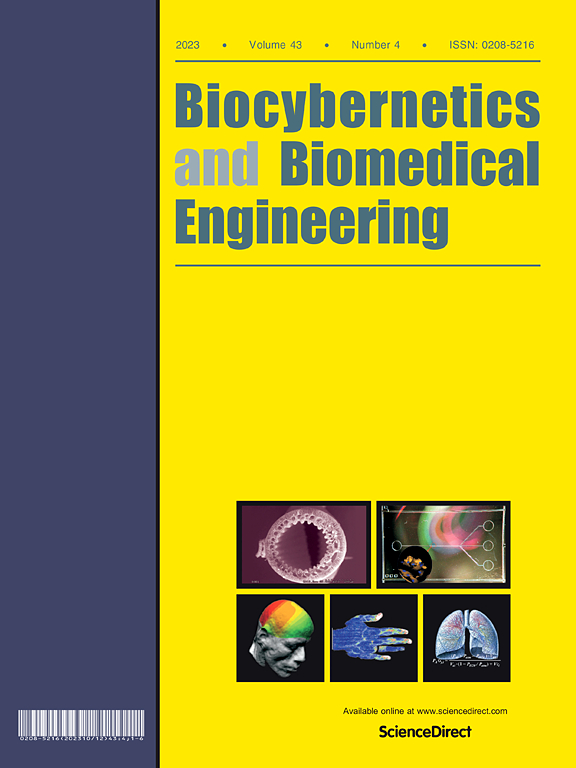Lumbar intervertebral disc biomechanics: Geometry and collagen fiber orientation configurations effects
IF 6.6
2区 医学
Q1 ENGINEERING, BIOMEDICAL
引用次数: 0
Abstract
This study proposes a probabilistic biphasic-swelling parameterized finite element framework, with the aim of which is to systematically evaluate the impact of lumbar intervertebral disc (L-IVD) geometry and annulus fibrosus collagen fiber configuration on multi-axial biomechanical behavior. Thirty anatomical L-IVD geometric sets were sampled via Latin hypercube sampling of clinical anatomical variations. Three annulus fibrosus layer-wise fiber configurations were implemented: Constant , Circumferential variation (), and Circumferential-radial variation (). Consequently, the construction of three groups, comprising a total of ninety biphasic L-IVD finite element models, was undertaken. Five loading protocols were then simulated to reveal the critical dependencies of L-IVD biomechanical behavior. A statistical comparative analysis was performed to evaluate the influence of disc geometries and orientation strategies. The findings demonstrated that fiber orientation configuration exerts a substantial influence on swelling responses, compression stiffness, and flexion stiffness (). Disc height exhibited strong inverse correlations with intradiscal pressure (, ) and compression stiffness (, ). Anterior-posterior length emerged as the primary predictor of sagittal stiffness (flexion: ; extension: ) and torsional resistance (), linked to altered moment arm mechanics. The nucleus pulposus volume ratio moderately affected intradiscal pressure (, ) but showed negligible impact on segmental stiffness. This parametric modelling framework facilitates systematic investigation of L-IVD biomechanics across anatomical variations. Additionally, these findings advocate for microstructure-informed computational models to optimize personalized implant designs and biomechanical assessments.
腰椎间盘生物力学:几何和胶原纤维取向构型的影响
本研究提出了一个概率双相肿胀参数化有限元框架,旨在系统评估腰椎间盘(L-IVD)几何形状和纤维环胶原纤维结构对多轴生物力学行为的影响。通过临床解剖变异的拉丁超立方体采样,对30个解剖L-IVD几何集进行采样。纤维环按纤维层的排列有三种:恒定的30°、圆周变化(25°- 45°)和圆周径向变化(23°- 50°)。因此,进行了三组,包括共90个双相L-IVD有限元模型的构建。然后模拟五种加载方案,以揭示L-IVD生物力学行为的关键依赖关系。我们进行了统计比较分析,以评估椎间盘几何形状和定位策略的影响。研究结果表明,纤维取向结构对膨胀响应、压缩刚度和弯曲刚度有实质性影响(p< 0.050)。椎间盘高度与椎间盘内压力(r< - 0.80, p<.001)和压缩刚度(r< - 0.85, p<.001)呈强烈的负相关。前后长度是矢状位刚度的主要预测因子(屈曲:r>;0.70;延伸:r>;0.75)和扭转阻力(r>0.50),与改变的力臂力学有关。髓核体积比适度影响椎间盘内压力(r>0.30, p< 0.05),但对节段刚度的影响可以忽略不计。这种参数化建模框架有助于系统地研究跨解剖变异的L-IVD生物力学。此外,这些发现提倡微观结构的计算模型,以优化个性化的种植体设计和生物力学评估。
本文章由计算机程序翻译,如有差异,请以英文原文为准。
求助全文
约1分钟内获得全文
求助全文
来源期刊

Biocybernetics and Biomedical Engineering
ENGINEERING, BIOMEDICAL-
CiteScore
16.50
自引率
6.20%
发文量
77
审稿时长
38 days
期刊介绍:
Biocybernetics and Biomedical Engineering is a quarterly journal, founded in 1981, devoted to publishing the results of original, innovative and creative research investigations in the field of Biocybernetics and biomedical engineering, which bridges mathematical, physical, chemical and engineering methods and technology to analyse physiological processes in living organisms as well as to develop methods, devices and systems used in biology and medicine, mainly in medical diagnosis, monitoring systems and therapy. The Journal''s mission is to advance scientific discovery into new or improved standards of care, and promotion a wide-ranging exchange between science and its application to humans.
 求助内容:
求助内容: 应助结果提醒方式:
应助结果提醒方式:


